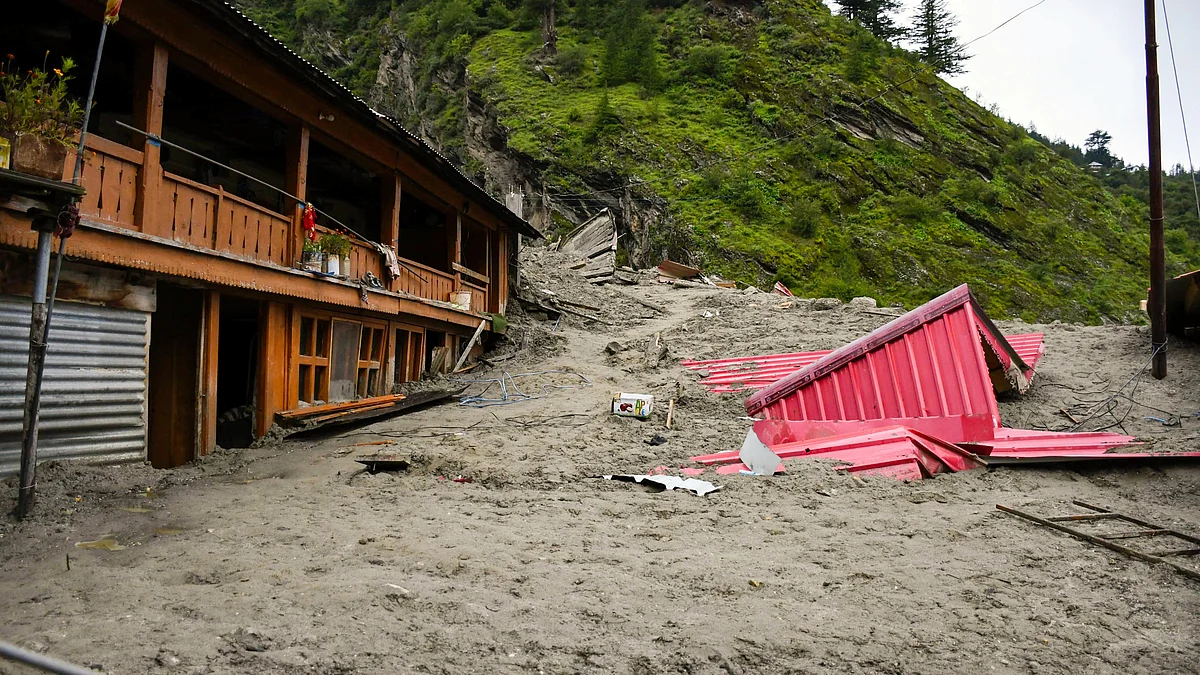Uttarkashi flash flood: Anger over bungled rescues; death toll disputed
Locals claim over 100 buried under debris in Dharali, say tourists given preference over locals during rescue

A devastating flash flood tore through Dharali village in Uttarkashi district on 5 August, leaving a trail of destruction, unanswered questions, and growing anger over the authorities’ faltering response. Officially, just four deaths have been confirmed and 43 people are listed as missing. On the ground, however, residents say the true toll is far higher — possibly approaching 100 — with many feared buried under 8 to 25 feet of debris.
The sudden disaster, triggered either by a cloudburst or a glacial lake outburst, unleashed a torrent of water, rocks, and mud that swallowed homes, hotels, shops, and even a riverside temple within minutes. The ferocity of the flow flattened roads, uprooted trees, and cut off the village from the outside world.
Rescue hampered by chaos
In the immediate aftermath, rescue operations by the Indian Army, Indo-Tibetan Border Police (ITBP), State Disaster Response Force (SDRF), National Disaster Response Force (NDRF), and the Border Roads Organisation (BRO) were hamstrung by blocked highways, torrential rain, and dangerously unstable terrain. Helicopters, sniffer dogs, drones, and makeshift ziplines were deployed, but progress was painfully slow.
By mid-week, roughly 200 people had been evacuated — about 130 on the night of 5 August and another 70 the next day. Survivors were airlifted to relief centres in Matli, Jolly Grant, and Chinyali. Yet residents accuse the authorities of misplaced priorities.
“There must have been over 100 people buried alive in the debris,” said Kameshwari Devi, whose son is missing. “We did not receive any help to save our loved ones. They saved tourists first.” Officials deny any preferential treatment, insisting rescue teams are searching for all victims using thermal imaging and canine units.
Conflicting death toll
The chasm between official figures and local estimates has deepened mistrust. While the state government has stuck to four fatalities, some local officials have privately acknowledged that at least five bodies have been recovered, and eyewitnesses claim many more remain unaccounted for, as per various media reports. Wikipedia’s compiled figures from various media sources suggest the toll could already be above 90.
Further complicating matters are several reports of journalists being prevented from reaching the disaster zone, strengthening suspicions that the administration is trying to hide the real picture.
The discrepancy is reminiscent of previous Himalayan disasters, where initial government tallies were later revised dramatically upwards as the scale of destruction became undeniable.
A disaster decades in the making
Uttarakhand’s fragile terrain and rapid, unregulated development have made it increasingly vulnerable to extreme weather events. In the past decade alone, 705 people have died in flash floods and landslides across the state, with almost 3,500 perishing in all forms of natural disasters. Scientists point to the combined effects of climate change, erratic rainfall, shrinking glaciers, and haphazard construction arising purely out of commercial considerations in hazard-prone zones as key drivers.
A new threat emerges
As if the current devastation were not enough, a temporary lake measuring roughly 400 to 500 metres has formed upstream in Harsil. Created when landslide debris blocked water flow, it now poses the risk of a sudden breach that could unleash another wave of flooding downstream.
The India Meteorological Department (IMD) has forecast heavy to very heavy rainfall for Uttarkashi and surrounding districts until at least 15 August, heightening fears that saturated slopes and swollen rivers could trigger fresh landslides or dam breaks.
Tales of loss and survival
Among those waiting anxiously for news is Suresh Rawat, whose brother, sister-in-law, and their two children were staying in a guesthouse that was swept away. “Not a brick is left. We’ve searched every corner,” he said, clutching photographs of the missing family.
Some rescues have been miraculous. An elderly couple trapped for nearly 30 hours was pulled from the wreckage of their home after rescuers heard faint cries. In another case, a group of tourists stranded on a rooftop was winched to safety just before the structure collapsed.
Demands for accountability
Opposition leaders and civil society groups have called for an independent inquiry into the state’s preparedness and response, accusing the administration of repeating mistakes made during the 2013 Kedarnath floods. “Every disaster follows the same script — slow rescues, underestimated tolls, and no accountability,” environmental activist Vimla Pant has been quoted as saying in media reports.
Chief minister Pushkar Singh Dhami visited the disaster site on 6 August, promising full support to affected families and swift restoration of infrastructure. He also appealed for patience, citing the logistical challenges posed by weather and geography.
For Dharali residents, patience is in short supply. With entire families missing, livelihoods destroyed, and another potential disaster looming upstream, their grief is laced with a simmering sense of betrayal.
As the floodwaters recede, the human cost of Uttarakhand’s latest tragedy is only beginning to emerge — and the gap between official assurances and lived reality has rarely felt wider.
Follow us on: Facebook, Twitter, Google News, Instagram
Join our official telegram channel (@nationalherald) and stay updated with the latest headlines
